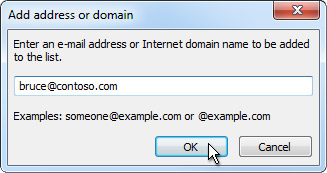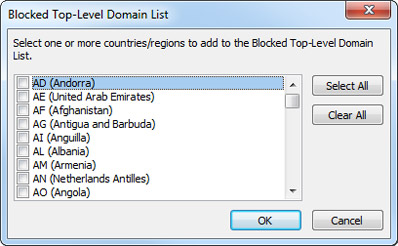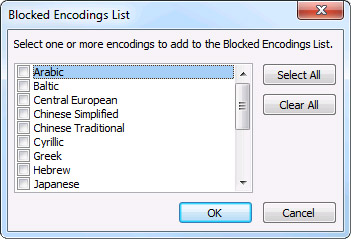Note: This article has done its job, and will be retiring soon. To prevent "Page not found" woes, we're removing links we know about. If you've created links to this page, please remove them, and together we'll keep the web connected.
The Outlook Junk Email Filter checks the sender of every incoming message against lists of email addresses and Internet domains — the part of the email address after the @ symbol — designated either as safe or to be blocked. Customize the filter to block or allow senders or message types.
What do you want to do?
Prevent trusted senders from being blocked
By adding email addresses and domain names that you trust to the Safe Senders List, you instruct Outlook that messages from those sources are never to be considered as junk. If you belong to mailing lists or distribution lists, you can add these names to your Safe Recipients List.
To add a person to the Safe Senders List, click a message from the sender, and then click Home. In the Delete group, click Junk, and then click Never Block Sender.
To add an email address or domain to the Safe Recipients List, click a message from the sender, and then click Home. In the Delete group, click Junk, and then click Never Block this Group or Mailing List.
If you don’t have a message from the person, you can still manually add email addresses or domains to these lists by doing the following:
-
Click Home.
-
In the Delete group, click Junk, and then click Junk Email Options.
-
Do one of the following:
-
To add safe senders, on the Safe Senders tab, click Add.
-
To add safe recipients, on the Safe Recipients tab, click Add.

-
-
In the Enter an email address or Internet domain name to be added to the list box, enter the name or address that you want to add. For example, you can add:
-
a specific email address, such as someone@example.com
-
an Internet domain, such as @example.com, or example.com
-
-
Click OK and repeat for each entry that you want to add.
-
If you want all Contacts to be considered safe senders, select the Also trust email from my Contacts check box on the Safe Senders tab.
-
Some people whom you correspond to might not be listed in your Contacts. If you want all such people to be considered as safe senders, select the Automatically add people I email to the Safe Senders List check box.
-
If you have existing lists of safe names and addresses, you can move that information into Outlook. Click Import from File and browse for the list file that you want. To create a file that uses your current list, click Export to File and then specify where you want the new file saved.
-
To change a name on either list, click the name that you want to change and then click Edit. To remove a name, click the name that you want and then click Remove.
-
If you are using a Microsoft Exchange Server account, all of the names and email addresses that are in your organization's address book — also known as the Global Address List — are automatically considered safe.
-
Block messages from someone
Messages from email addresses or domain names in the Blocked Senders List are always treated as junk. Outlook moves any detected incoming message from senders in the Blocked Senders List to the Junk Email folder, regardless of the content of the message.
Note: The Outlook Junk Email Filter doesn’t stop junk email from being delivered, but instead diverts suspected spam to the Junk Email folder. You can change the sensitivity of the Junk Email Filter by changing its level of protection, or use third-party solutions, which can be more aggressive.
To add someone to the Blocked Senders List, click a message from the sender, and then click Home. In the Delete group, click Junk, and then click Block Sender.
If you don’t have a message from the person, you can still manually add email addresses to the Blocked Senders List:
-
Click Home.
-
In the Delete group, click Junk, and then click Junk Email Options.
-
On the Blocked Senders tab, click Add.

-
In the Enter an email address or Internet domain name to be added to the list box, enter the name or address that you want to add. For example, you can add:
-
a specific email address, such as someone@example.com
-
an Internet domain, such as @example.com, or example.com.
-
-
Click OK and repeat for each entry that you want to add.
Notes:
-
If you have existing lists of safe names and addresses, you can move that information into Outlook. Click Import from File and browse for the list file that you want. To create a file that uses your current list, click Export to File and then specify where you want the new file saved.
-
To change a name on the list, click the name that you want to change and then click Edit. To remove a name, click the name that you want and then click Remove.
-
If you are using a Microsoft Exchange account, all of the names and email addresses that are in your organization's address book — also known as the Global Address List — are automatically considered safe and can’t be added to the blocked list.
-
Block messages from particular country/region codes
You might find that unwanted email messages come from particular countries/regions. By using the Blocked Top-Level Domain List, you can block messages from those areas. This list blocks messages from email addresses that end in a particular top-level domain or country/region code. For example, selecting the CA [Canada], US [United States], and MX [Mexico] check boxes in the list blocks messages where the sender’s email addresses ends in ca, us, or mx. Additional country/region codes appear in the list.
-
Click Home.
-
In the Delete group, click Junk, and then click Junk Email Options.
-
On the International tab, click Blocked Top-Level Domain List.

-
In the list, select the check box for the country/region code that you want to block, or click Select All.
-
Click OK in both open dialog boxes.
Block messages that contain unfamiliar alphabets
You can block all email message by language encodings — also known as character sets or alphabets. Today, most junk email is sent in the U.S.-ASCII encoding. By using the Blocked Encodings List, you can filter out unwanted email messages that are displayed in languages that you don't understand.
-
Click Home.
-
In the Delete group, click the arrow next to Junk, and then click Junk Email Options.
-
On the International tab, click Blocked Encodings List.

-
In the list, click the language encoding that you want to block, or click Select All.
-
Click OK in both open dialog boxes.
Notes:
-
Unicode encodings aren’t included in the Blocked Encodings List.
-
Messages that have unknown or unspecified encodings are subject to filtering by the regular Junk Email Filter.










